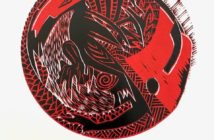Behind the scenes at Pukehinahina
Maori didn’t lose their land because of an inability to organise. An on-going event like the commemoration of the battle of Pukehinahina-Gate Pa is a testament to the huge organisational and business skills of local iwi. None of this happened overnight and the extent and professionalism of the events, and I mean all the ancillary art, poetry, speaking competitions and functions not just what was publically visible on the 29th of April 2014 required a military approach to achieve the level of success that it did.
The faces of soldiers are generally not individually seen and we the public may not be aware of the contributors to an event such as this commemoration. I have no idea who the polite young man was at the vehicle entry along Cameron Road or how long he stood there in that cold wet morning. I know how long the mature female Maori Warden had stood in the same cold wet morning because she was still standing when I came back in the afternoon and we both talked about feeling the cold and our feet. I heard a young man point to someone moving the big green rubbish bins and say “hey someone’s doing my job”
It’s mid-afternoon when I sit down on the wooden platform in front of the flagpole. The elderly woman next to me starts a conversation. She introduces me to the woman sitting alongside her and informs me that “this lady’s school made up 2,000 breakfasts” I’m intrigued. It transpires “this lady” is the principal of a Kura Kaupapa). I ask if I can have her contact details and in clear and uniform teacher writing Rapua Timoti the Principal of Te Kura Kaupapa Maori o Otepou writes them into my notebook.
My request to meet students involved in the breakfast preparation is agreed and I drive out of the urban fringe of Welcome Bay into its rural heartland. The Kura buildings sit quite close to the road with their backs to it. A large multi-trunked totara stands guard immediately behind the wooden school sign.
This school started life as the Papamoa Native School in the 1800’s and the main building is now a heritage building. I’m startled by how familiar the traditional layout and design of the buildings feel and wonder if this what those country schools I spent my first five years in New Zealand looked like. I am introduced to two of the senior students Kataraina Smallman and Mauri-Paihere Totorewa and Mrs Melanie Smallman, the school secretary/administrator who is also the mother Kataraina. While they wait to talk with me the girls read their ipads. I’ve come with notebook and ballpoint. I’m not the first visitor today, politicians have visited for morning tea.
We go to the library and I sit so a photo of the three of us can be taken. It’s hard to decide who’s being interviewed as the ipads record us. I move to sit opposite them and then I hear about “the train” and the “stations” – factory style organisation for fruit salad, juice, yoghurt, coffee, croissants, chocolate fish. These two don’t see what happened as any big deal – they are used to participating “helping out” in the preparation and organisation of powhiri and tangi. They give credit to the Brazilian students from the adjacent bible college.
What I learn is that Melanie is the daughter of kaumatua from a nearby Ngati Pukenga Marae and was delegated this organisational task by her Mother. “It just took a couple of phone calls.” Everybody helps. They talk about delivering the food to the tents for the haka party for the powhiri at Pukehinahina and taking round trays of food to make sure there is food for each iwi’s participants. Melanie didn’t stop after breakfast, she stayed to help out for the rest of the day. She mentions the ladies from the Church serving tea all day and the sausage sizzle – “she thought she should stick around” I think one or both of the girls was also part of the haka party – what a day.
I ask each young woman what their aspirations are – and they have them and they are regularly taken to visit the University of Waikato. Rapua has mentioned the story of the three whales. Mauri-Paihere tells me the story in Maori and Kataraina translates it to English for me.
There will be at least a hundred stories like Melanie’s, Kataraina’s and Mauri-Paihere’s. People who gave their time, talents and abilities to the commemoration.
I thought I’d end this tiny insight by telling you that the other week, after the crowds had gone and the site was cleared I was driving up Cameron Road towards the Maleme Street recycling station. Parked on Cameron Road in front of the line of pouwhenua was a large bus out of which had got a group of “visitors” who were busily photographing the pou and the reserve site. I think all the sponsors, volunteers and council contributions have been to the creation of an ongoing “asset” for Tauranga. I believe the comparatively modest amount contributed by our territorial authorities to the commemoration will be repaid in ongoing community benefit. In fact Tauranga has probably received far in excess the cash value of ratepayer contribution in national and international media coverage.





